More About How I'm Still Scrapbooking in 2025 | Sizes, Styles, and Stories
More than you ever wanted to know about how I scrapbook my stories
We’re back with Part 2 of the “What Is Scrapbooking in 2025?” series—and today’s all about how I physically put my scrapbooks together: the sizes I use, the styles I love, and how I figure out what kind of story I’m telling in the first place.
Scrapbooking isn’t one-size-fits-all. That’s one of the reasons I love it so much. I get to change things up depending on my energy, my supplies, the season, or whatever photo I’m excited about that day. In this post, I’m walking you through what’s working for me right now—and how you can mix and match these formats to make your own practice feel good.
In Part 1, I shared why I scrapbook, how it fits into my everyday life, and why feminist scrapbooking is such a big part of my creative practice.
If you haven’t read that yet, I’d recommend starting here.
There’s no one-size-fits-all way to scrapbook—and that’s kind of the best part.
Here’s what we’ll cover in this email:
My go-to scrapbook sizes (and how I store them)
The different styles I use—from traditional layouts to art journal mashups
How I figure out what kind of story I’m telling (and where it should live)
Let’s dive in ✂️📓
📏 Scrapbook Sizes
There’s no one “right” size for scrapbooking—just what works best for your brain, your stories, and your shelf space. I’ve scrapbooked in everything from 12×12 albums to tiny pocket-sized notebooks, and they’ve all had their season. These days, I’m living in 6×8; but, when the mood strikes, I’ll spend a long weekend in something a little different.

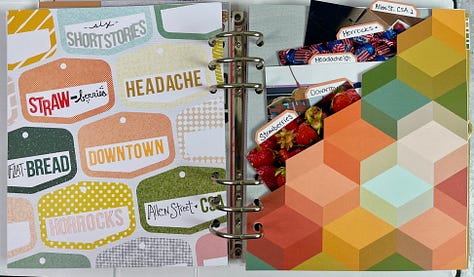
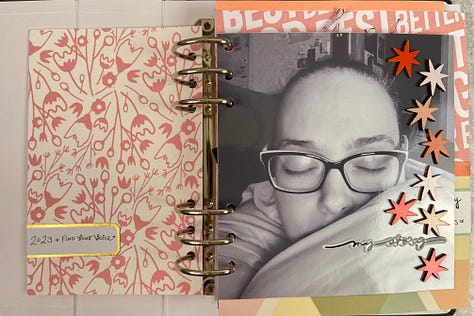


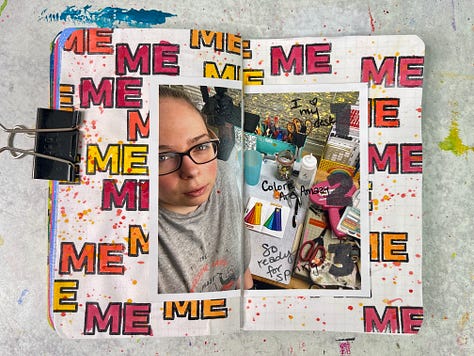
6×8 Is My Sweet Spot
If I’m working on a scrapbook layout, chances are it’s going into a 6×8 album. I love this size for so many reasons:
It’s great for single photo pages (which I make a lot of)
Square photos look fantastic on these pages
It’s small enough to finish in one sitting but big enough to tell a full story
It’s also super flippable, which makes it more fun to revisit. I keep all my 6×8 albums lined up in a bookcase, and I love being able to pull one out and flip through a season of my life in an afternoon.
Big Albums (When the Story Needs Room)
I’ve done 12×12 Project Life albums and 10×8 albums for special projects. I love the visual impact of big photo spreads—and they can hold a lot. But big pages also take more time, energy, and physical space. You basically need to sit on the couch and pull the book across your lap. I don’t reach for them as often anymore. That said, they’re still perfect for certain stories (vacations, events, or year-long projects) and worth the effort when you’ve got a story that feels bigger than usual.
Just...maybe don’t ask me how I feel about storing 12×12 albums. (Spoiler: they’re huge and in storage in my garage. But still worth it.)
Mini-Albums
Mini-books are a forever fav. I’ve made them out of everything from leftover packaging to accordion folds to ring-bound—chipboard, cardstock, clear acetate—all the things. I especially love them for photo-heavy projects, themed stories (travel albums most of all), and creative experiments. There’s something satisfying about finishing a whole book and knowing that story is done and complete.
Daily Pages (Inside Field Notes notebooks)
Most of my creative play happens in my Daily Pages notebooks—usually small Field Notes size. This is where I experiment with new supplies, try out layouts, and tell the smaller, everyday stories that don’t always make it into my scrapbooks. It’s also where I practice ideas for bigger projects. Daily Pages are 100% part of my scrapbooking flow—just with fewer rules and a lot more stickers.
🎨 Scrapbook Styles
Traditional Layouts
Photos + journaling + paper = the classic scrapbook formula. I still love this approach, especially in my 6×8 albums. A single photo, a little journaling, and some fun stuff layered around it? That’s my kind of page. Some are quick and simple, others are loaded up with gel prints, stamping, or collage—but it all starts with a photo and a story I want to tell.
Pocket Pages
Pocket pages give you structure without a ton of pressure. You can slide things in and be done, or you can use them to break up bigger spreads with little moments. I used them all the way through my 12×12 Project Life albums, and I still love adding them into my 6×8 albums when I have a bunch of little things I want to include—like extra photos, ephemera, or short updates.

Art Journal-ish
I pull from art journaling all the time—especially when I want a messier, more expressive page. Paint, stencils, gel plates, collage, scraps, scribbles. These pages live somewhere between a journal and a scrapbook, and that’s part of what makes them so fun. Sometimes there’s no photo. Sometimes there’s no journaling. Sometimes it’s just vibes, and that’s okay too.
Digital + Hybrid Elements
I still do most of my scrapbooking by hand, but when I’ve got a lot to say, I’ll type out journaling blocks and print them onto sticker paper or cardstock. I’ve also printed full digital scrapbooks—especially for screenshot-heavy projects like my Digital Diary. For me, digital tools are just another supply I can use to tell my story.
You don’t have to pick one style and stick with it. Try things out. Mix and match. Do what feels good this week—and then do something completely different next time.
Your story gets to look however you want it to. 🎉✂️📓
✍🏻 Types of Stories I Scrapbook
Most of my all about me scrapbook pages fall into one of three broad categories: everyday stories, adventure stories, or introspective stories. I don’t overthink it—this isn’t a checklist—but it helps me recognize what kind of story I’m working with and how I might want to approach it.
Everyday Stories
These are the right-now moments: what we ate this week, what I’m watching, what’s blooming outside the window. It’s the stuff that might seem boring until it’s gone, and then you’d give anything to remember what your Tuesday afternoons used to feel like.
This is where my Currently Lists live. My Daily Pages. Random photos of lunch or my desktop or whatever I couldn’t stop talking about that week. These pages are low-pressure and totally essential. They hold my life together.
Adventure Stories
Vacations. Big events. Milestone memories. I love scrapbooking these kinds of stories—sometimes in their own albums, sometimes spread out across layouts. I’ve done full travel albums, themed projects like Week in the Life, and big recap pages that document a stretch of time.
These pages usually have a little more structure—here’s what happened, then this, then this—but I still give myself plenty of room to play. Just because it’s a “big” story doesn’t mean it has to look serious.
Introspective Stories
These are the stories I tell when I’m thinking something through. They’re more about how I’m feeling than what happened. Some of them start in Daily Pages. Some get turned into art-journal-style spreads. Some live inside mini-books or typed-out journaling blocks.
These might be about burnout, body image, identity, creative shifts, or whatever I’ve been sitting with for a while. I make space for this kind of storytelling because it helps me grow—and because the inside stuff deserves just as much room as the outside stuff.
Sometimes one page holds all three. Sometimes a story changes shape halfway through.
It doesn’t need to be perfect. It just needs to be real.
Your Turn: What kind of story are you telling right now?
Weekly Resource List:
What is Scrapbooking (10-minute read): Everything you need to know about Scrapbooking.
rukristin’s Creative Challenges (link resource): Last year’s National Scrapbooking Day celebration—challenges, articles, and more.
CAF EP 137: Three Story Styles (65-minute listen) In this episode, we talk about my framework for telling scrapbook stories, and how almost every story can be broken up into one of the three categories.
Everyday, Introspective, Adventure: Tell Amazing Stories with Joy and Ease (7-minute read): More details about the Everyday, Introspective, and Adventure story types.
A Selection of My Mini Albums (link resource): Different types of mini-albums that I (and friends) created over the years; binder rings, DIY, pre-made albums, and more.
Here’s what we covered today:
Why 6×8 albums are my go-to (and how I use others too)
The different styles I use to tell different types of stories
A simple framework to help you figure out what you’re scrapbooking
Action step:
Pick one photo that’s been sitting in your camera roll and ask yourself: what kind of story does this tell? Then try jotting down a few words or grabbing some supplies to start building a page around it. No pressure—just play.
That’s all it takes to start telling your story. 💕
Hit reply and let me know how you’re scrapbooking in 2025.
Talk to you next week!
xoxo,
Kristin
P.S. If you’re enjoying these newsletters, please consider sharing this edition with a friend who might need a little creative boost today.
And if you’re new—or just checking back in, here are 3 ways I can help you scrapbook your stories:
Upgrade your Substack subscription and join me on the first Saturday of the month for our live masterclasses, a new topic each month on building and sustaining your creative habit. See the full archive here.
Check out the free Awesome Ladies Project community and join us for challenges, free stickers, and amazing friendships!



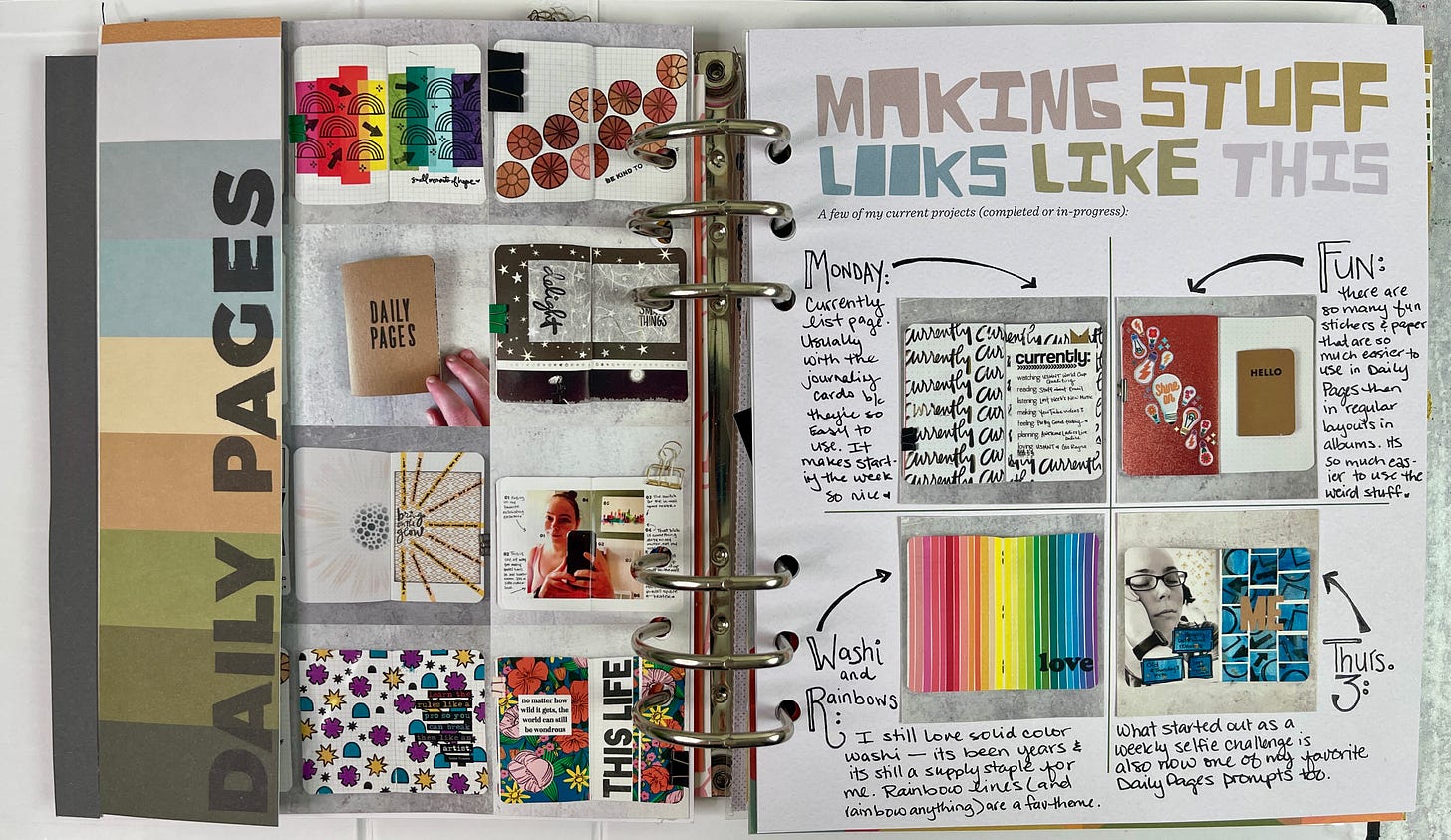








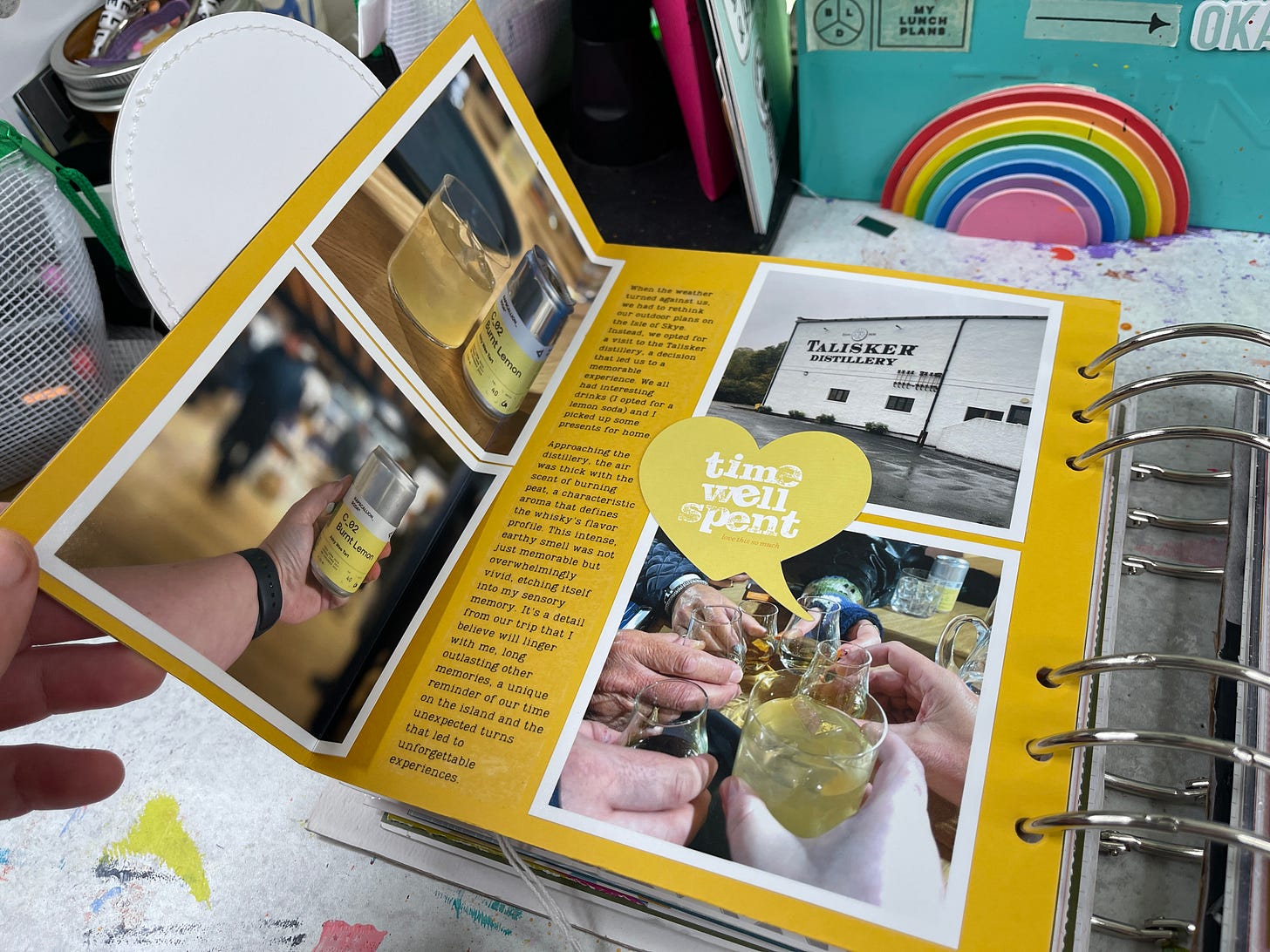

Great insight into your process, and how others may start scrapbooking their stories (I have been scrapbooking for many, many years).
This is great!! I’ve been a card maker for a while but am dipping my toe into scrapbooking. I let the thought overwhelm me and my brain knew I couldn’t match up to the perfect pages I saw online. My ADHD perfection paralysis is real.
Seeing your process and end result is amazing. No rules, no right or wrong…just whatever feels and looks good. I’m going to embrace this now!!